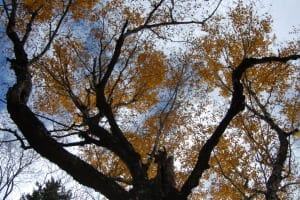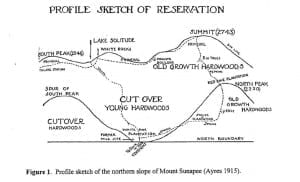 Q. – The manager of Okemo/Mount Sunapee Resort has repeatedly stated that there is no old growth in the proposed expansion area. How do you and the Friends of Mount Sunapee respond to that claim?
Q. – The manager of Okemo/Mount Sunapee Resort has repeatedly stated that there is no old growth in the proposed expansion area. How do you and the Friends of Mount Sunapee respond to that claim?
A. – It is essential to understand that, even among forest ecologists, there is some debate over the definition of the term old growth. Quite frankly, the wording can be a semantic trap. The resort operators are missing the point by focusing on the term.
The focus should be on the facts:
1) New Hampshire Natural Heritage Bureau (NHB) identified and documented the existence of exemplary forest communities directly in the path of the proposed expansion.
2) Because of this designation, these forests are protected under state law (Native Plant Protection Act RSA 217- A:7).

3) These forests do contain large, magnificent, old trees. Some of the older trees within the mosaic of exemplary forest communities on Mount Sunapee have been found to be over 250 years of age. These ancient trees are part of an ecological community, a complex interplay of plants (both living and dead), animals (including microscopic organisms), fungi, and soils that are not found in other, far more common forests that have been historically managed (i.e. logged) by humans. These unmanaged areas are the last remnants of the primeval forests that covered much of this area prior to European settlement.
4) The forests on Mount Sunapee are living laboratories, valuable to forest scientists, for educational purposes, and for simple enjoyment by the public. And, they occur in Mount Sunapee State Park, land protected many years ago and held in the public trust.
5) The first priority of Hamsphire Parks according to state law (RSA 216-A:1) is “To protect and preserve unusual scenic, scientific, historical, recreational, and natural areas of the state.”
What better fits that mandate than these beautiful exemplary forest communities?
Figure 1 (above), included in the NHB study (1999) “Old Forests and Rare Plants at the Mount Sunapee Ski Lease Area,” illustrates the reservation’s forest history on Mount Sunapee.
The reports states: “The original purchase of 656 acres in 1911 by the Society for the Protection of New Hampshire Forests was initiated to protect land from extensive logging which started in 1906 (Ayres19150). By 1934, SPNHF owned 1,185 acres, including cut-over and old-growth forests. In 1948, the state took ownership of the mountain and opened the Mount Sunapee State Park with a ski area on the north face of the mountain (MacAskill 1981).” – NH Natural Heritage Bureau (1999)
